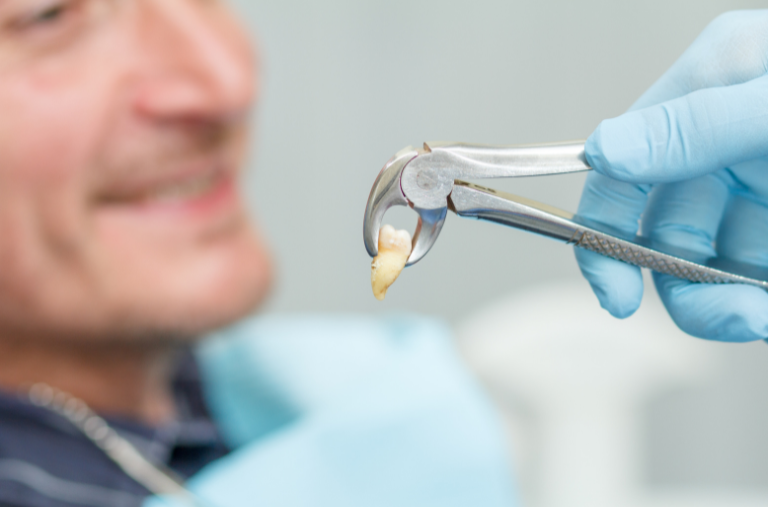Tooth Extraction
Extraction means to remove the tooth from the mouth.
Extraction of a tooth is always considered as a last resort for our dentists and they will endeavor to save every tooth, if it is safe and possible to do so. However, sometimes a tooth cannot be saved, and an extraction is the best long term treatment.
Reasons Why We Would Extract a Tooth:
- Trauma: When a tooth experiences trauma that cannot be rectified through other dental procedures such as a crown or root therapy, tooth removal may be necessary. This is often the best option when a tooth is damaged beyond repair.
- Infection / Swelling: In cases of severe infection or swelling, a patient might choose extraction over root therapy, especially if the infection is causing significant discomfort. This choice can help alleviate pain and prevent further complications.
- Failed root therapy: Tooth extractions are often required when previous root canal treatment fails. A tooth that has undergone root therapy but still causes problems may need to be removed to prevent additional issues.
- Repeat infection / Inflammation of Wisdom Tooth: Repeated infection or inflammation of wisdom teeth frequently necessitates removal. Wisdom teeth can cause severe pain and crowding, leading to the need for the extraction of the impacted wisdom teeth by a dentist or oral surgeon.
- Crowded Teeth: In situations where the mouth is overcrowded and there is insufficient space for all teeth to align properly, tooth extraction may be recommended. This is especially common in preparation for orthodontic treatment to create space and improve alignment.
- Severe Pain: Sometimes severe pain from an impacted tooth or other dental issues may lead to the decision for tooth removal. Extracting the problematic tooth can relieve pain and prevent further oral health issues.

What Happens During an Extraction?
We want you to feel as comfortable and relaxed as possible during every treatment, so local anesthetic will be available to ensure there is no pain/sensitivity. There is also an option for sedation for those with dental anxiety.
Once anesthesia has been established, the dentist will very gently ease the tooth out with special techniques. These are small, controlled movements of pressure that gently widen the socket and detach the tooth from the ligaments holding it in place. It is simply then a case of removing the tooth with forceps.
Usually, the tooth will be removed in one piece, however if a tooth is heavily filled or broken down, it may require additional care. Surgical extraction is the term used for the requirement of accessing the tooth from gum level. This sometimes means the dentist will have to remove some gum tissue or bone to enable them to remove all of the tooth. Stitches are commonly required, and some further aftercare, but the treatment is relatively straight forward.
extraction aftercare
After a surgical extraction, it’s always important to closely follow post-care instructions to ensure a fast recovery and avoid any complications.
- If you have had local anesthetic, it may take up to 4-6 hours for the effects to wear off. During this time, please ensure that you refrain from chewing your lip, inner cheek, tongue or soft tissues and drinking hot drinks to avoid unwittingly causing trauma to the area.
- Your mouth has been worked on, so there may naturally be a small amount of tenderness, bruising and sensitivity to the area for a couple of days. If there are still worsening symptoms of pain after 7 days, contact the practice for advice.
- Do not rinse your mouth out for at least 24 hours after an extraction. This will help the blood to clot in the socket.
- After 24 hours, dissolve a teaspoon of salt in a glass of warm water. Take a sip, gently gargle the solution spit out. The salt will help cleanse the area and limit the chance of infection.
- It is important to keep your mouth clean. Brush your teeth as normal, but avoid brushing the area of treatment for 24 hours, then going gently for a few days around the area.
- Avoid food and drinks that are hot / cold /spicy / tough as the area will be sensitive.
- If you start to bleed again, do not worry. Roll some pack into a sausage, place it over the bleeding socket and press down for 15 minutes
- Make sure you take some painkillers for the first 24 hours. These will help to reduce the pain and swelling. After this, take them as and when you feel you need them. Ibuprofen and paracetamol are good painkillers to use. Avoid taking aspirin as it may cause bleeding. If you are asthmatic, avoid taking ibuprofen as it may worsen your asthma.
- Take it easy for the rest of the day; avoid demanding physical work or exercise.
- Refrain from drinking alcohol for the first 24 hours, as this can encourage bleeding and delay healing.
- AVOID smoking for at least 2 days after treatment. Smoking reduces the rate of healing and increases the risk of infection, which can be very painful.
- If you feel small pieces of bone working their way out of the socket, don’t worry – this is normal.
- If the socket becomes more painful a day or two after the extraction, call us to discuss the possibility of the socket having become infected. If this does happen it is usually easily treated with a special pack
tooth extraction frequently asked questions
Tooth extraction is the removal of a tooth from its socket in the bone. It can be performed by a dentist or an oral surgeon.
Reasons for tooth extraction include severe trauma, infection, failed root therapy, repeated inflammation of wisdom teeth, overcrowding, and severe pain.
The two main types are simple extractions, which are performed on visible teeth, and surgical extractions, which are more complex and often involve impacted or broken teeth.
Your dentist or oral surgeon will administer local anesthesia to numb the area. For more complex cases, sedation may be used. The tooth is then carefully removed from the socket.
Follow your dentist’s or oral surgeon’s instructions, which may include avoiding certain foods and medications. Arrange for someone to drive you home if sedation is used.
After the procedure, you’ll need to rest and avoid strenuous activity to promote healing. It’s important to follow the post-extraction care instructions provided by your dentist or oral surgeon. Initially, you may experience some dental pain, which can be managed by taking prescribed medications or over-the-counter pain relief as recommended. Applying ice packs to the affected area can help reduce swelling and discomfort.
To protect the tooth socket and extraction site, avoid rinsing your mouth vigorously, using straws, or smoking, as these actions can dislodge the blood clot and delay healing. Stick to a diet of soft foods to avoid irritating the extraction site.
Most patients experience a significant reduction in pain and swelling within a few days, but full healing of the tooth socket can take one to two weeks. Following these care guidelines will help ensure a smooth and comfortable recovery.
In many cases, replacing the extracted tooth is recommended to prevent the shifting of adjacent teeth and other dental issues including bone loss. Options include dental implants, bridges, and dentures.


